K. W. Samuel Au
Multiscale Medical Robotics Center, Hong Kong, China
DOFS: A Real-world 3D Deformable Object Dataset with Full Spatial Information for Dynamics Model Learning
Oct 29, 2024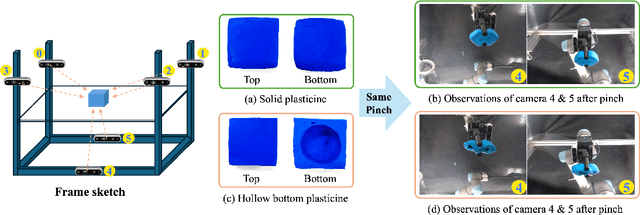
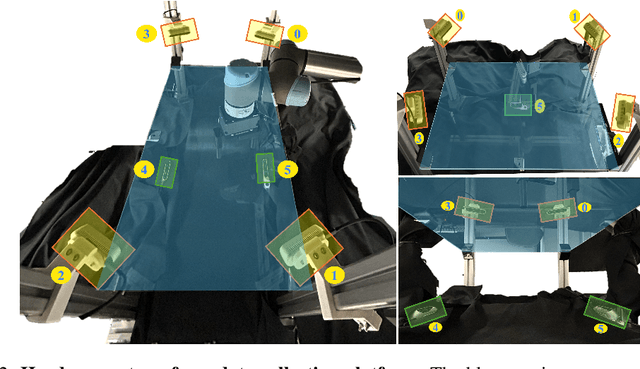
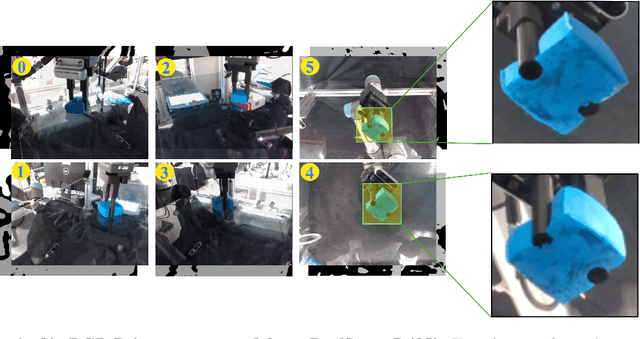

Abstract:This work proposes DOFS, a pilot dataset of 3D deformable objects (DOs) (e.g., elasto-plastic objects) with full spatial information (i.e., top, side, and bottom information) using a novel and low-cost data collection platform with a transparent operating plane. The dataset consists of active manipulation action, multi-view RGB-D images, well-registered point clouds, 3D deformed mesh, and 3D occupancy with semantics, using a pinching strategy with a two-parallel-finger gripper. In addition, we trained a neural network with the down-sampled 3D occupancy and action as input to model the dynamics of an elasto-plastic object. Our dataset and all CADs of the data collection system will be released soon on our website.
Needle Segmentation Using GAN: Restoring Thin Instrument Visibility in Robotic Ultrasound
Jul 25, 2024Abstract:Ultrasound-guided percutaneous needle insertion is a standard procedure employed in both biopsy and ablation in clinical practices. However, due to the complex interaction between tissue and instrument, the needle may deviate from the in-plane view, resulting in a lack of close monitoring of the percutaneous needle. To address this challenge, we introduce a robot-assisted ultrasound (US) imaging system designed to seamlessly monitor the insertion process and autonomously restore the visibility of the inserted instrument when misalignment happens. To this end, the adversarial structure is presented to encourage the generation of segmentation masks that align consistently with the ground truth in high-order space. This study also systematically investigates the effects on segmentation performance by exploring various training loss functions and their combinations. When misalignment between the probe and the percutaneous needle is detected, the robot is triggered to perform transverse searching to optimize the positional and rotational adjustment to restore needle visibility. The experimental results on ex-vivo porcine samples demonstrate that the proposed method can precisely segment the percutaneous needle (with a tip error of $0.37\pm0.29mm$ and an angle error of $1.19\pm 0.29^{\circ}$). Furthermore, the needle appearance can be successfully restored under the repositioned probe pose in all 45 trials, with repositioning errors of $1.51\pm0.95mm$ and $1.25\pm0.79^{\circ}$. from latex to text with math symbols
Interactive Navigation in Environments with Traversable Obstacles Using Large Language and Vision-Language Models
Oct 13, 2023Abstract:This paper proposes an interactive navigation framework by using large language and vision-language models, allowing robots to navigate in environments with traversable obstacles. We utilize the large language model (GPT-3.5) and the open-set Vision-language Model (Grounding DINO) to create an action-aware costmap to perform effective path planning without fine-tuning. With the large models, we can achieve an end-to-end system from textual instructions like "Can you pass through the curtains to deliver medicines to me?", to bounding boxes (e.g., curtains) with action-aware attributes. They can be used to segment LiDAR point clouds into two parts: traversable and untraversable parts, and then an action-aware costmap is constructed for generating a feasible path. The pre-trained large models have great generalization ability and do not require additional annotated data for training, allowing fast deployment in the interactive navigation tasks. We choose to use multiple traversable objects such as curtains and grasses for verification by instructing the robot to traverse them. Besides, traversing curtains in a medical scenario was tested. All experimental results demonstrated the proposed framework's effectiveness and adaptability to diverse environments.
Model-Free Large-Scale Cloth Spreading With Mobile Manipulation: Initial Feasibility Study
Aug 21, 2023Abstract:Cloth manipulation is common in domestic and service tasks, and most studies use fixed-base manipulators to manipulate objects whose sizes are relatively small with respect to the manipulators' workspace, such as towels, shirts, and rags. In contrast, manipulation of large-scale cloth, such as bed making and tablecloth spreading, poses additional challenges of reachability and manipulation control. To address them, this paper presents a novel framework to spread large-scale cloth, with a single-arm mobile manipulator that can solve the reachability issue, for an initial feasibility study. On the manipulation control side, without modeling highly deformable cloth, a vision-based manipulation control scheme is applied and based on an online-update Jacobian matrix mapping from selected feature points to the end-effector motion. To coordinate the control of the manipulator and mobile platform, Behavior Trees (BTs) are used because of their modularity. Finally, experiments are conducted, including validation of the model-free manipulation control for cloth spreading in different conditions and the large-scale cloth spreading framework. The experimental results demonstrate the large-scale cloth spreading task feasibility with a single-arm mobile manipulator and the model-free deformation controller.
* 6 pages, 6 figures, submit to CASE2023
Towards Exact Interaction Force Control for Underactuated Quadrupedal Systems with Orthogonal Projection and Quadratic Programming
Oct 19, 2022



Abstract:Projected Inverse Dynamics Control (PIDC) is commonly used in robots subject to contact, especially in quadrupedal systems. Many methods based on such dynamics have been developed for quadrupedal locomotion tasks, and only a few works studied simple interactions between the robot and environment, such as pressing an E-stop button. To facilitate the interaction requiring exact force control for safety, we propose a novel interaction force control scheme for underactuated quadrupedal systems relying on projection techniques and Quadratic Programming (QP). This algorithm allows the robot to apply a desired interaction force to the environment without using force sensors while satisfying physical constraints and inducing minimal base motion. Unlike previous projection-based methods, the QP design uses two selection matrices in its hierarchical structure, facilitating the decoupling between force and motion control. The proposed algorithm is verified with a quadrupedal robot in a high-fidelity simulator. Compared to the QP designs without the strategy of using two selection matrices and the PIDC method for contact force control, our method provided more accurate contact force tracking performance with minimal base movement, paving the way to approach the exact interaction force control for underactuated quadrupedal systems.
Learning Deep Nets for Gravitational Dynamics with Unknown Disturbance through Physical Knowledge Distillation: Initial Feasibility Study
Oct 04, 2022
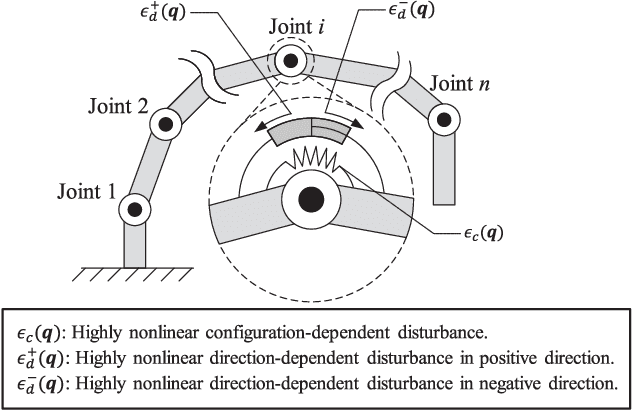
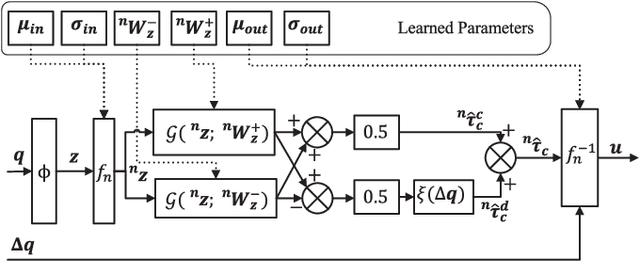
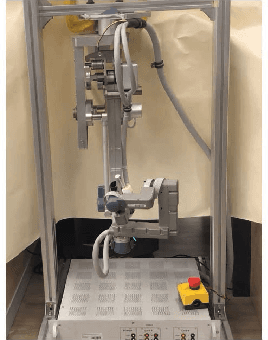
Abstract:Learning high-performance deep neural networks for dynamic modeling of high Degree-Of-Freedom (DOF) robots remains challenging due to the sampling complexity. Typical unknown system disturbance caused by unmodeled dynamics (such as internal compliance, cables) further exacerbates the problem. In this paper, a novel framework characterized by both high data efficiency and disturbance-adapting capability is proposed to address the problem of modeling gravitational dynamics using deep nets in feedforward gravity compensation control for high-DOF master manipulators with unknown disturbance. In particular, Feedforward Deep Neural Networks (FDNNs) are learned from both prior knowledge of an existing analytical model and observation of the robot system by Knowledge Distillation (KD). Through extensive experiments in high-DOF master manipulators with significant disturbance, we show that our method surpasses a standard Learning-from-Scratch (LfS) approach in terms of data efficiency and disturbance adaptation. Our initial feasibility study has demonstrated the potential of outperforming the analytical teacher model as the training data increases.
Towards Safe Landing of Falling Quadruped Robots Using a 3-DoF Morphable Inertial Tail
Sep 30, 2022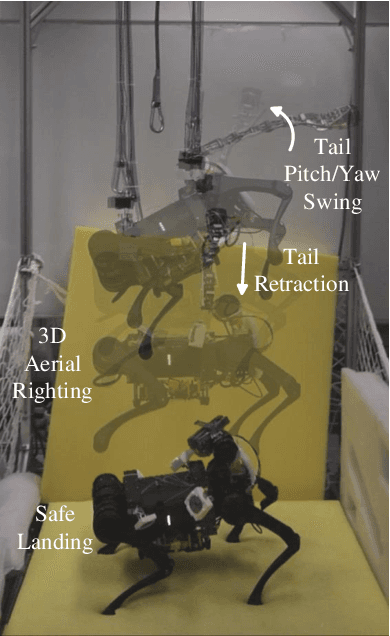
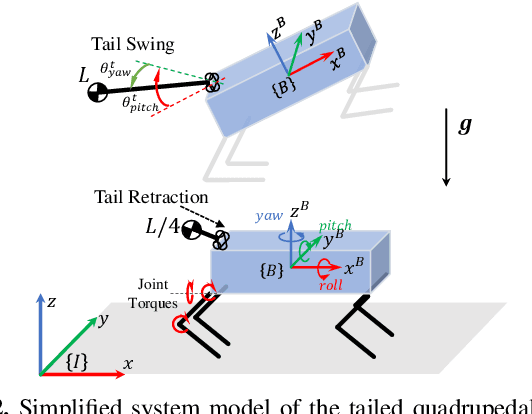
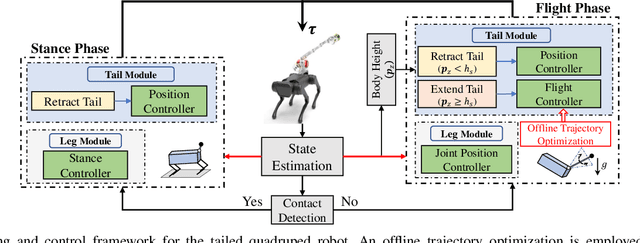
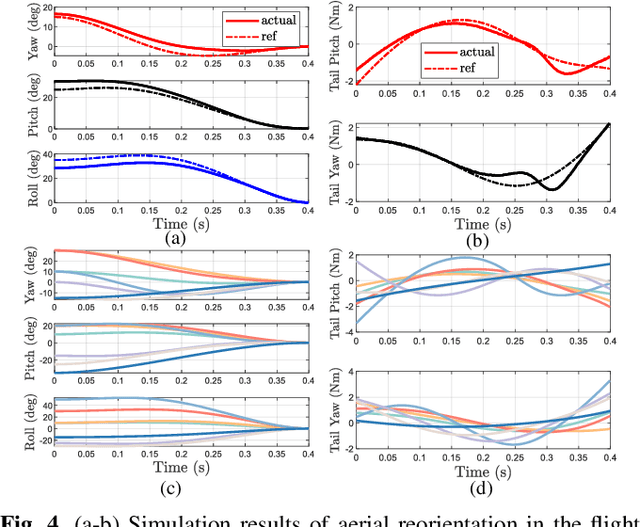
Abstract:Falling cat problem is well-known where cats show their super aerial reorientation capability and can land safely. For their robotic counterparts, a similar falling quadruped robot problem, has not been fully addressed, although achieving safe landing as the cats has been increasingly investigated. Unlike imposing the burden on landing control, we approach to safe landing of falling quadruped robots by effective flight phase control. Different from existing work like swinging legs and attaching reaction wheels or simple tails, we propose to deploy a 3-DoF morphable inertial tail on a medium-size quadruped robot. In the flight phase, the tail with its maximum length can self-right the body orientation in 3D effectively; before touch-down, the tail length can be retracted to about 1/4 of its maximum for impressing the tail's side-effect on landing. To enable aerial reorientation for safe landing in the quadruped robots, we design a control architecture, which has been verified in a high-fidelity physics simulation environment with different initial conditions. Experimental results on a customized flight-phase test platform with comparable inertial properties are provided and show the tail's effectiveness on 3D body reorientation and its fast retractability before touch-down. An initial falling quadruped robot experiment is shown, where the robot Unitree A1 with the 3-DoF tail can land safely subject to non-negligible initial body angles.
HM-DDP: A Hybrid Multiple-shooting Differential Dynamic Programming Method for Constrained Trajectory Optimization
Sep 15, 2021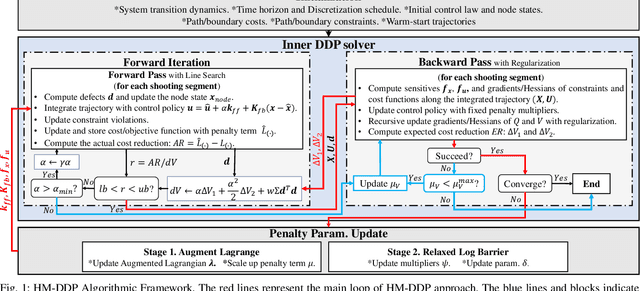
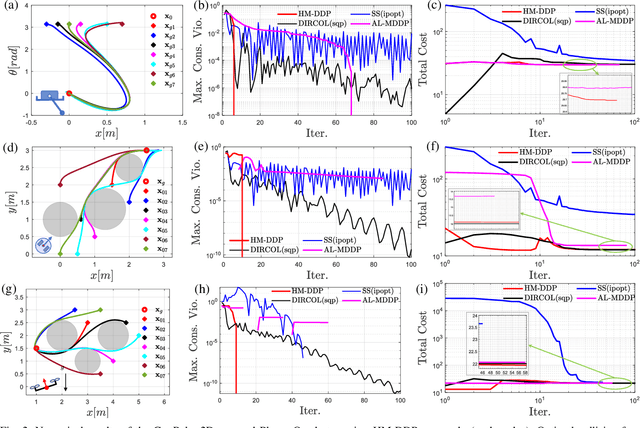

Abstract:Trajectory optimization has been used extensively in robotic systems. In particular, Differential Dynamic Programming (DDP) has performed well as an off-line planner or an online nonlinear model predictive control solver, with a lower computational cost compared with other general-purpose nonlinear programming solvers. However, standard DDP cannot handle any constraints or perform reasonable initialization of a state trajectory. In this paper, we propose a hybrid constrained DDP variant with a multiple-shooting framework. The main technical contributions are twofold: 1) In addition to inheriting the simplicity of the initialization in multiple shooting, a two-stage framework is developed to deal with state and control inequality constraints robustly without loss of the linear feedback term of DDP. Such a hybrid strategy offers a fast convergence of constraint satisfaction. 2) An improved globalization strategy is proposed to exploit the coupled effects between line-searching and regularization, which is able to enhance the numerical robustness of DDP-like approaches. Our approach is tested on three constrained trajectory optimization problems with nonlinear inequality constraints and outperforms the commonly-used collocation and shooting methods in terms of runtime and constraint satisfaction.
A Reliable Gravity Compensation Control Strategy for dVRK Robotic Arms With Nonlinear Disturbance Forces
Jan 17, 2020



Abstract:External disturbance forces caused by nonlinear springy electrical cables in the Master Tool Manipulator (MTM) of the da Vinci Research Kit (dVRK) limits the usage of the existing gravity compensation methods. Significant motion drifts at the MTM tip are often observed when the MTM is located far from its identification trajectory, preventing the usage of these methods for the entire workspace reliably. In this paper, we propose a general and systematic framework to address the problems of the gravity compensation for the MTM of the dVRK. Particularly, high order polynomial models were used to capture the highly nonlinear disturbance forces and integrated with the Multi-step Least Square Estimation (MLSE) framework. This method allows us to identify the parameters of both the gravitational and disturbance forces for each link sequentially, preventing residual error passing among the links of the MTM with uneven mass distribution. A corresponding gravity compensation controller was developed to compensate the gravitational and disturbance forces. The method was validated with extensive experiments in the majority of the manipulator's workspace, showing significant performance enhancements over existing methods. Finally, a deliverable software package in MATLAB and C++ was integrated with dVRK and published in the dVRK community for open-source research and development.
 Add to Chrome
Add to Chrome Add to Firefox
Add to Firefox Add to Edge
Add to Edge